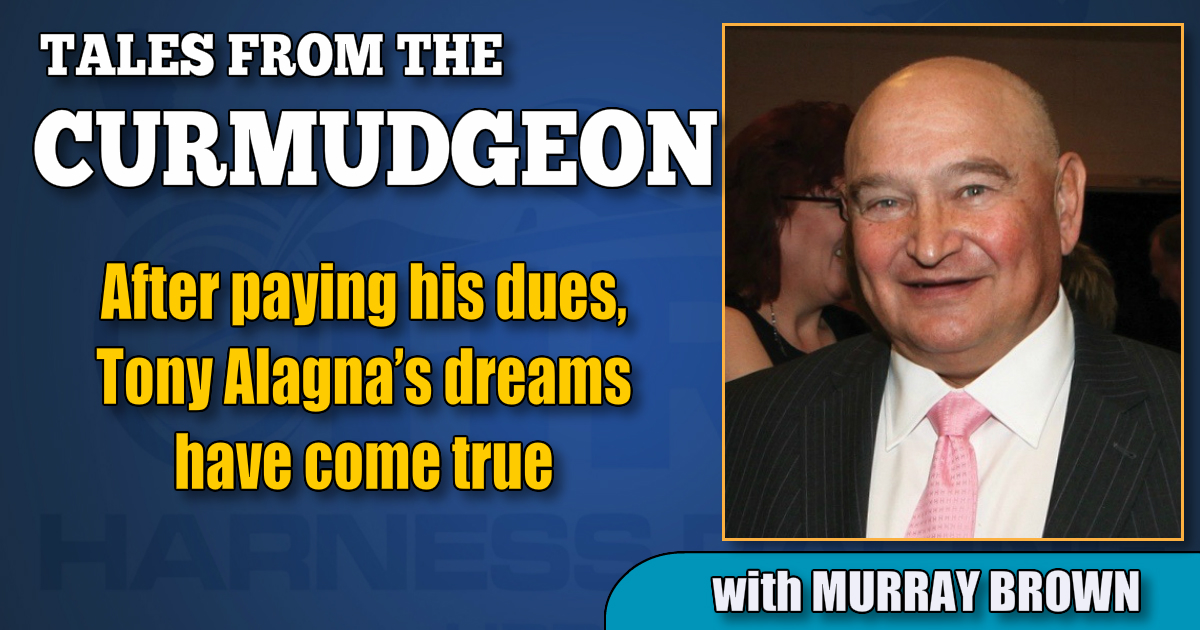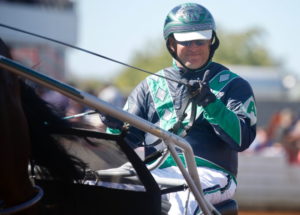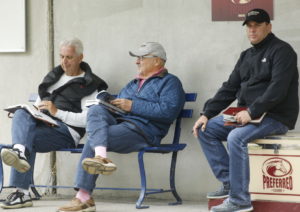After paying his dues, Tony Alagna’s dreams have come true
by Murray Brown
Imagine this: You have spent your whole life around horses — all sorts of horses.
You feel you are ready. You’ve paid your dues. You’ve worked with and tried to emulate some of the greatest horsemen on the planet. You think you are ready to go out on your own.
Your dream is to have a stable of yearlings that you hope you can help develop into quality racehorses and hopefully have a great one or more along the way.
That’s your dream. Sometimes dreams do come true, but so often does reality.
The year is 2009. You have decided you are going to go out on your own.
For the last six years you have been second trainer for Erv Miller, one of the top horsemen of this generation.
You mention going out on your own to Myron Bell, who together with George Segal’s Brittany Farms had some horses in training with Erv.
Bell’s response was “What the hell took you so long?”.
Thus, Tony Alagna’s climb to where he is now reached its mid-point.
He was looking for his big break and now he thought he had got it.
He told Bell that his plan was to assemble a group of well-bred yearlings, take them to Florida and hopefully assemble a stable of what would become Grand Circuit horses.
Bell told him that he was making a mistake. “What if your yearlings don’t make it?” he asked. (How prophetic that was going to be). “What you need to do is establish a stable of racehorses in New Jersey. You need for people to see you and become acquainted with what you can do. You need a mix of racehorses to fall back on if the yearlings don’t make it.”
Alagna went to the yearling sales with the backing of Bell and Brittany. They studied their lessons and bought several what they believed were high quality yearlings, a few of them weren’t cheap. None of them turned out to be what Tony hoped they would become.
Thank goodness Alagna had some success with his racehorse stable. Eric Cherry had purchased a filly who had been racing well in Iowa named Laughandbehappy. Eric’s trainer, Ross Croghan, asked Alagna if he would race her for them at The Meadowlands to get some idea of how good she was. Alagna responded, “I’d baby sit a German Sheppard for you if you asked me.” She turned out to be very good. She swept all the legs and the final of a winter series at The Meadowlands. Tony, hopefully, was on his way.
The next fall he felt he had blown his chance with yearlings.
After the way his 2-year-olds had under-performed, he felt that there was no way Segal and Bell would reinvest with him. He was wrong. Bell told him, “It wasn’t your fault. We just picked bad horses. We’ll try it again this year.”
That year they had much more success. Among their purchases were the stakes horses Major Bombay and Nicki Beach.
The next year, lightning struck. His name was Captaintreacherous.
What brought Tony Alagna to that point?
He grew up in Illinois with his mom Donna Lee. Then, and to this day, she has been the biggest asset in his life.
He was always involved with horses.
Among his fondest memories were traveling the Illinois Fair Circuit with his mom and their small stable.
In that time frame, he also showed Morgans and American Saddlebreds.
He began to assemble a wealth of knowledge about horses, the chief being to keep them healthy and happy.
His first job working for a high-powered stable was with his dear friend and mentor Brian Pinske.
Pinske taught him a great deal, but perhaps most important to Tony Alagna, Pinske placed a great deal of trust in him and his ability to get the job done.
“Brian had it all. He could do everything there was to do with a horse. He was a great yearling picker. He was a great trainer. He was also a good farrier and driver. Most importantly, he was a wonderful person. He loved life and people. I didn’t know Billy Haughton, but from what I experienced with him, he was as close to being someone like him than anybody since. Tragically, for all who knew them, they were both taken from us far too soon.
“After Brian passed away, I went back to school for a short time hoping to become a vet. I realized that wasn’t for me. I then trained Pat and Doc Walker’s Fox Valley Farms horses for four years. They made it well known that if their yearlings didn’t bring what they thought they should, they would retain and train those. I was put in charge of their racing stable. They, in effect, became a victim of their own success with the horses that they bred doing so well, the prices rose to the point that they didn’t need to train near as many.
“It was then that I went to work for Erv. I worked with Erv for six years. Erv operates a huge stable and does it extremely well. I think I learned a great many things from working with him, among them being the ability to be able to manage more than a small number of horses and people.
You have assembled a great group of owners, let’s talk about some of them.
Myron Bell and George Segal – “I’m sure that I’d have attained some degree of success without them, but I’m fairly certain it would be nowhere related to the scale and the amount of time it’s taken. There are people who consider Myron to be abrasive and he certainly can be that. But at heart, he is a kind, caring person who if you are his friend, he will be at your back whenever and wherever. I speak with him just about every day, sometimes several times and not always about horses.
“George is a great person as well, but in a different manner. He is the relatively rare sort of person who is able to compartmentalize and prioritize his life. He knows what he knows and what he doesn’t know or even want to know. He works with good people and has trust in their abilities. I speak with him occasionally, but not that often. As some may have experienced, when speaking with George, one may not know that the conversation is over until you have a dead phone in your hand.”
Brad Grant – “One great guy. I first came to know him when his Apprentice Hanover was racing against Captaintreacherous. I sold him a few horses over the years that we both made out well on. I remember him asking me about a filly he was trying to buy, ‘If she is this good, why are you selling her to me?’ I responded ‘because I race and sell horses for a living and you do something that enables you to buy these horses.’ That filly turned out to be Sandbetweenurtoes who is still racing and has earned $1,049,148. Eventually Brad approached me and said, ‘Why don’t we cut out the middle phase of this relationship and have you buy them as yearlings that I can own from the beginning.’ Of course, I loved his thinking on that.”
John Fodera and Steve Winnick – “I’m grouping these two together because they are great friends of each other and great friends of mine. If you see John’s name on one of mine, Steve’s is usually there as well. John has been a dear friend for as long as he has been with me. He has been almost like a father figure. Our relationship transcends racing.”
Dana Parham – “An absolutely brilliant man. When he decides to do something, he is focused on doing it as well as he can possibly do it. When I first became acquainted with him, he was almost entirely out of the business. He had spent untold millions of dollars with very little success. I got perhaps his last racehorse, Odds On Equluus to train for him. I think it was more than that he had an emotional attachment to him that he decided to keep him racing. We did quite well. Dana had become friends and partners with Eric Cherry with whom he learned to focus on quality race fillies — particularly well-bred pacing fillies. He is into buying the best available yearling pacing fillies on the market. I have no doubt that within a reasonable period of time he will have assembled one of the greatest broodmare bands in the industry.”
Robert Leblanc – “Another great guy. Actually, there is probably nobody in my present ownership group that I wouldn’t consider to be a wonderful person. Robert is extremely bright and very personable. He loves the business and is thirsty for knowledge. I think he might be a trifle spoiled though, having Ramona Hill as one of the first horses that he has owned.”
Al and Michelle Crawford – “Two wonderful people. They are involved in virtually every phase of the business. They breed, raise, race, sell, buy and find homes for horses. They are extremely kind and generous and wonderful to have in the stable.”
Mom – “She is the best, despite sometimes being a pain in the ass. She pretty much supervises the business aspect of the operation. She carries a whole load off of my shoulders by running the Canadian segment of the stable. In addition, I know that when I send a horse there it will be trained and treated in the same way as if I were with it. She has her own people who work with her there and has had them for some time.”
How about a few of the horses?
Captaintreacherous – “Myron went to the sale knowing that his group was either going to own him or that whoever did was going to have to pay a whole lot more than what he actually brought. On a scale from one to 10, we considered him to be at least a 12. He had everything going for him. We looked at all the Somebeachsomewhere yearlings in his first crop. He was in our opinion not only the best looking one, he was also the best bred one. George Segal has a group of different people independently looking at yearlings for him. He then assembles all that information in his great mind. The conclusion of all, was that he was ‘the one.’ Of course, he went out and did everything and more than that was expected of him on the racetrack and is now doing the same in the breeding shed.”
Ramona Hill – “She was a gorgeous filly as was her dam Lock Down Lindy. She was a heat winner in the Hambletonian Oaks, but at times just couldn’t put it all together. She comes from a strong Canadian family, the one that produced Majestic Son. A self-professed pedigree snob like Myron probably wouldn’t even have bothered to look at her. I’m guessing he just would have turned her page. I fell in love at first sight. As soon as I first saw her, I knew in my mind that I was going to buy her. I’d worry about owners later. Her ownership group of Brad Grant, Al & Michelle Crawford, Robert Leblanc, John Fedora and Steve Winnick quickly came together.
“She was a late foal, so we didn’t rush her. She always showed some brilliance. We decided to skip the Doherty Memorial at The Meadowlands and instead shipped her to Lexington. Dr. Mitchell did some work on her back which I believe helped her a great deal.
“We raced her in the Kindergarten Series to give her some racing experience. She finished the year by winning the Breeders Crown in spectacular fashion.
“Her win in the Hambletonian elimination just might have been the greatest performance I’ve seen in all my years in harness racing. What happened before and right after the half didn’t please Andy McCarthy very much.”
Maverick – “He’s the one most people talk about given his price. He’s a big horse that needs a little time. People have asked if I’m disappointed. Decidedly not. He has a lot of talent, but I’m not about to push him beyond what I think he might be physically and mentally prepared for. Thankfully, the partners all agree. I’m probably going to take him to Lexington, maybe race him there a few times and then probably turn him out and allow him to grow, fill in and become the horse that I believe he is supposed to be.”
Who is the best horseman you’ve ever been around?
“Most people of this generation would probably say Jimmy Takter and I certainly could not argue with them. He is a great talent, a hard worker and someone who is not glued to the past. He is not afraid to try something new or even somewhat revolutionary. But I’m probably going to surprise you with my choice.
“I think I learned more by working for three months with Dan Altmeyer than I did in a small period of time with anybody else in the horse business.
“In addition to being a great guy and a great horseman, he does everything the right way. If a young person came to me and asked me where he could go to work and learn a great deal, I wouldn’t hesitate to recommend Dan and now his son in law Mike Wilder.
“I never knew Keith Waples. So many speak of him with great reverence as a great teacher. He taught not by showing or telling you what to do, but by example. If you watched and followed what he did, you couldn’t help but learn. The same is the case with Dan.
* Author’s Note – It’s not a surprise to me at all. I’ve known Dan Altmeyer for decades. I’ve also had horses with him. He personifies the word class.
When we spoke, you were just coming from looking at yearlings. Two questions
1. What’s it like looking at yearlings without Myron?
“It’s certainly less time consuming. It’s also less edifying. Looking at horses with Myron exposes you to a wealth of information, much of it the result of an incredibly great memory, but also some that will help you in deciding your choices.”
2. Where do you see the yearling market going this year?
“One thing that is fairly certain to me is that there will be no million-dollar yearlings this year.
“The market will definitely be down. I’m guessing somewhere from 30 to 40 per cent. In addition to the problems we have in the world today, I think that not having some of the buyers at the sales in person will detract from the emotion that being at a horse sale generates. The thought of ‘just one more bid’ or ‘that guy cannot outbid me’ will not occur. There will also be a surplus of young horses who didn’t pay their way, but of which not enough is known that will be retained, thus taking the stall of a yearling that could be bought. I’m still going to do my homework as well as I can so that I am prepared when opportunity presents itself.”
Have a question for The Curmudgeon?
Reach him by email at: hofmurray@aol.com.




















